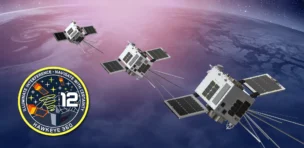Today marks the last day that NASA’s Tracking and Data Relay System satellites will be open for new business. From here on out, NASA science missions operating near Earth will instead rely on a set of commercial constellations.
The Circle of Life: The first TDRS satellites were launched in the 1980s to support NASA’s growing fleet of spacecraft, including Shuttle missions, the ISS, and a variety of EO satellites. The system of communications satellites in geosynchronous orbit make sure NASA missions can stay in touch with operators on Earth.
As the spacecraft reach the end of their life, NASA decided to turn to private companies instead of building, launching, and operating a new comms system. TDRS will come to an end in the 2030s, replaced by a fleet of commercial sats purchased through the Commercial Services Project (CSP).
“You’ve got commercial LEO destinations, you’ve got commercial landers, you’ve got commercial launch,” Kevin Coggins, NASA’s deputy associate administrator for space communications and navigations, told Payload. “They can close on business cases and make investments in space relay—many of the companies on CSP, they were doing it anyway.”
Here comes the hand-off: NASA is providing $278.5M to six companies (Inmarsat , Kuiper, SES, SpaceX, Telesat, Viasat) and partnering with a seventh (Kepler) through an unfunded Space Act agreement, to work through integration into NASA’s Near Space Network.
When future NASA planners enter the design phase, they’ll pass their requirements to Coggins’ team, who will match them with one or more commercial providers suited to their mission.
It’s not just replacing existing capabilities, either: New technologies like laser comms and access to different spectrum could mean better performance for users.
Demo zone: Right now, providers are testing what they’ll be able to offer to NASA missions. ViaSat, for example, will demonstrate its relay capabilities with a Loft Orbital satellite in 2025, and in 2026, deploy a Rocket Lab-built spacecraft to enhance its network.
SpaceX’s Polaris Dawn mission also showed off the company’s “plug and plaser,” an optical communications terminal that could be installed on any spacecraft to communicate with the Starlink network.
“That’s a hard problem,” Coggins says of linking two moving spacecraft in orbit via laser communications. “To actually do it and to demonstrate it like they did on Polaris One—that’s impressive, which is why it was a proof point in the program.”
Move with the times: This isn’t the first time NASA has turned to commercial comms: the agency handed a chunk of its ground segment over to providers like KSAT and SSC. Private comms will also play a role in path-breaking future missions, with Intuitive Machines winning a contract to provide communications around the Moon.
The logic behind these partnerships is straightforward.
“NASA will not have to finance the building and maintaining the constellation,” Coggins told Payload. “We will become just a service user…our only cost will be the cost every other user pays to access data throughput, so it’ll be a significant cost savings.”




